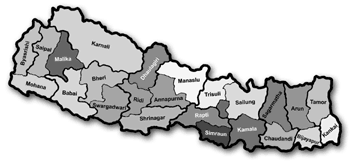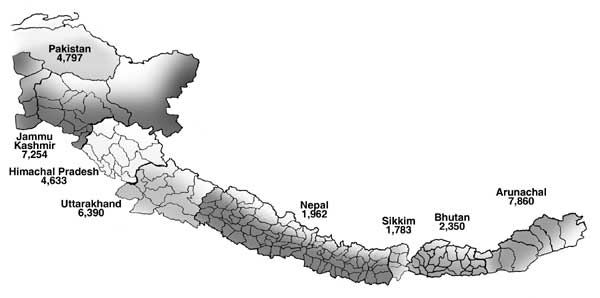 Decentralisation has been an incessant theme in Nepal over the past five decades. The Ranas used it for cosmetic purposes, during the Panchayat period it was used to sustain the elite power base, and for good governance in the present democratic setup.
Decentralisation has been an incessant theme in Nepal over the past five decades. The Ranas used it for cosmetic purposes, during the Panchayat period it was used to sustain the elite power base, and for good governance in the present democratic setup. These past initiatives all floundered on the bedrock of the centralised governance system. Even now, there is no evidence that the central government and entrenched bureaucracy are becoming amenable to some form of local autonomy.
There is a need for conceptual clarity on the forms and functions in the decentralisation process. Delegation and deconcentration are basically related to the exercise of administrative authority in which the lower hierarchies are allowed tenancy. Devolution, on the other hand, is related to political authority including autonomy in local governance. Unlike delegation, whereby functions are assigned, devolution involves exercise and sharing of power. This is contingent on the relative strength of the contending parties. In Nepal, the centre is too pervasive and the districts too weak without economic viability.
The economic status of districts is the basis of their capacity to bear the cost of administration. Presently, most districts are dependent on the grants from the centre even for their regular budget because of their fragile financial base. Only eleven of 75 districts are in surplus: seven in the tarai, three in the hills and one in the inner tarai. Their high revenue is mainly due to customs receipts, except for Chitwan, which has a national park, and Lalitpur, which depends on excise.
There is a wide income variation among District Development Committees according to their geographic location. The higher the elevation zone, lower their income. On average, a tarai district is ten times more resourceful than a mountain district.
The major item of expenditure in most districts is public works and manpower. Most of the expenses were supported by grants from the central government. This dependence on grants from Kathmandu ranges from 84 percent in Bardiya to 99 percent for Bajura. Most districts are generally more dependent on Kathmandu for support, depending on the centre even to run their District Development Committees. The decentralisation of authority to such entities without fiscal autonomy has been an exercise in futility.
The paraphernalia of government agencies have also grown by leaps and bounds over the years. In 1963, 35 districts were expanded to 75 with an additional tier of 14 zones. In 1972 four, and later five, regional centres were established with directorates of various ministries. Then development projects established more offices at the district level. Consequently, there has been a massive increase in regular expenditure for administration in the districts.

There are 146 administrative districts in the Himalaya between the Indus and Bramhaputra rivers. These include 75 in Nepal, 49 in Indian states, 20 in Bhutan and four in Pakistan. The average area of a district is 2,350 sq km in Bhutan, 4,979 sq km in Pakistan and 6,065 sq km in India. The average for Nepal: 1,962 sq km. The proposed 25 district-Nepal (see top map) will mean an average area of 5,887 sq km.
It is clear that the problem of decentralisation has less to do with a legal framework than with economic viability. As a consultant to the Constitution Reform Recommendation Commission in 1975, I had proposed the re-organisation of the 75 districts into 40. The proposal was based on an economic rationale, but was rejected for political reasons. Since then, there has been much extension in roads, airports and telecommunications. These have narrowed the geographic space enabling the administration of a much larger area. The reduction in the number of districts also seems a logical option to economise administrative cost.
The present district consolidation proposal is to reduce the number of administrative districts to 25 from 75. The new districts are based on regrouping two to four current geographically contiguous districts. The headquarters of the most centrally located current district would be the new headquarter of the enlarged district. Elsewhere, it would be a new township with a highway or airport. The present 75 districts could be relegated to ilaka, or sub-district level with their headquarters converted to service centres.
This rationalisation of districts should also be extended to Village Development Committees. Of the Rs 630 million total budget allocated in 1999 to the districts, 30 percent was for VDC secretaries. If the number of VDCs was slashed by half, there would be a saving of Rs 95 million annually. Larger districts would also mean a larger revenue base. Resource mobilisation in the re-consolidation of districts would require delegation of functions to local bodies instead of the expansion of the central administration that has stunted local initiative and capability.
Districts can function as autonomous bodies only if they have an adequate resource base. This would mean curtailing the present highly centralised budgetary allocation system and empowering districts with more taxation authority. District income could also be enhanced by allocating a certain percent of revenue from the district's natural resource exploitation.
One innovative scheme to mobilise district revenue would be to replicate the buffer zone programme around the Royal Chitwan National Park (RCNP). VDCs in the buffer zone received 20 percent of the tourism revenue from the national park for community and conservation activities.
Mountain districts are considered the poorest in terms of revenue sources. Yet much of the revenue they generate is diverted to the central exchequer. If the Chitwan model for revenue sharing is adopted, tourism-dominated districts would be much better off. For instance, the Everest area generated tourism revenues of nearly $900,000 through climbing royalties, trekking and park entrance fees. This was 2.6 times the district's total revenue. If only half the tourism receipts were to be retained in Solu-Khumbu, the amount would be nearly eight times the central government grant to the district.
Similarly, Upper Mustang yielded $737,000 from trekking fees in 1998. Of this income, 3.3 percent went to the Annapurna Area Conservation Project and the rest to the central exchequer. If this amount were to be shared, Mustang would have eight times more revenue than the current central grant to the district.
There has been much discussion on the legal framework of the Local Self-governance Act 1999, which endorses the concept of devolution. A realistic approach towards decentralisation needs to first clarify the confusion between delegation of central functions and devolution of authority to local entities. This implies a drastic change in the relationship between the central government and the district hierarchy. The decentralisation effort in Nepal has failed due to the command system and economic fragility of the districts. And district autonomy is feasible only through the consolidation of their economic base with a wider tax base and revenue sharing of income from local resource use.
(Dr Harka Gurung is a geographer and former Tourism Minister. He is currently with the research organisation, New Era. This article was adapted from his paper delivered at a Society for International Development seminar in Kathmandu on 24 March.)


